The 6 Best Affordable Acoustic Guitars for the Recording Studio
Today we’re going to look at a handful of the best affordable acoustic guitars for the recording studio. In this roundup, we’ll focus on steel string acoustics that can be had for well under $1,000.
Know What You Need
What are our criteria? A great acoustic guitar for the studio should have the best unplugged sound quality you can get within your budget, a comfortable feel—and yes—also good looks, that will inspire musicians to pick up the instrument and express themselves.
A built-in pickup system can be a nice bonus for the studio, allowing you to unleash some very creative and useful advanced recording techniques. But to make this list, a guitar must have among the best raw acoustic sounds in its price range.
For those of you who already have your bases covered on traditional six-string acoustics, we’ve even included a couple of less conventional options that can round out any studio or recording guitarists’ collection—including our pick for one of the best affordable 12-strings around.
Best Affordable Acoustic Guitars for the Recording Studio
With that in mind, here are some of the most comfortable-playing and great-sounding affordable acoustics I’ve had the pleasure to test in the past year:
1. Taylor 114ce (Street price: $799)
Taylor is undeniably one of the industry standards in acoustic guitars today, and at $799, the 114ce is a high-quality, affordable introduction to the unmistakable Taylor guitar sound.
As with much of the Taylor line, the neck on this instrument is quite thin and comfortable, making it especially suitable for electric guitar players looking to transition to a real guitar.
The sapele wood back and sides and sitka spruce top also make for a very vibrant sounding guitar, and the whole instrument resonates quite a lot due to this tone wood combination, and thanks in part to the lack of a heavy gloss finish on the body and neck.
Because the varnish on the body is very thin, which makes this guitar resonate more than it otherwise might, you’ll want to be careful not to scratch or drop the guitar too often, as it could show wear fairly quickly. (Unless you like that kind of thing!)
Taylor guitars tend to work very well as live instruments as they are generally bright and clear-sounding instruments that rarely or never come across as muddy or boomy. This kind of tone makes the 114ce a particularly good fit if you plan to play or record acoustic guitars in the context of a loud rock band setting or a really dense mix. Taylor acoustics shine in these kinds of scenarios as they will cut through the mix without much EQ, and without sounding thin or tinny, either.
If you plan on recording just voice and guitar however, you may want to consider some of the other guitars on this list, which offer a bit more body and warmth that can help fill up more space on their own and complement sparse, vocal-driven arrangements.
2. Martin DRS2 (Street price: ~$799)
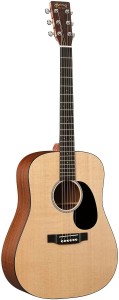
The DRS2 offers the iconic full-bodied and well-balanced Martin tone at an especially affordable price point.
The DRS2 is one of the coolest offerings from Martin in recent years, and a great competitor with the Taylor 114ce, as the two instruments can be found at essentially the same price point.
The Martin and Taylor lines tend to put out very different-sounding guitars from one another, in much the same way that Fender and Gibson have found their own niches on each end of the tonal spectrum in the electric guitar world.
Though both of these companies offer great consistency among their offerings, I am not alone in having a certain affection for the Martin sound that is hard to explain.
Because there have been so many “classic” recordings created using Martin guitars, I immediately associate the familiar and distinctive Martin tone with the sound of a great, well-recorded guitar. Like a great Strat, Les Paul, or Ludwig Supraphonic snare drum, a good Martin just sounds “right” and, in the right hands, immediately iconic.
This particular guitar is quite full and warm sounding, but well-balanced tonally. The neck is very comfortable and easy to play and it should appeal to those who want to get a good recorded sound quickly.
The included pickup in this model is obviously not ideal for recording, and I would definitely recommend using a mic on this guitar when you are in the studio. But, it could serve as a welcome additional source—especially for effects and monitoring—or if you need an instrument to double for live use.
3. Epiphone Masterbilt DR-500MCE (Street Price: ~$649)
I once had the privilege of being able to visit the Gibson Showroom and borrow any of the guitars on display for a couple of days for a recording session.
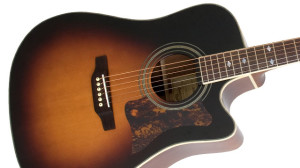
Epiphone’s Masterbilt series offers some surprisingly well-crafted guitars that are ready to compete with instruments that go for twice the price.
While there, I tried out every single acoustic guitar they had on the wall, and was surprised to find that this Epiphone Masterbilt was my personal favorite, regardless of price.
I know, I know, I thought it was strange too, but I’ve since noticed that Zakk Wylde also uses one of these Masterbilt guitars on his live acoustic dates, so maybe I’m not too crazy after all.
“Epiphone Masterbilts. They play like Les Pauls. The action is phenomenal, and that’s always the bitch with acoustics,” Wylde told Guitar World in 2011. “Everyone always complains, ‘Dude, the further up the neck I go, the action’s like 20 feet off the fretboard!’ but these Masterbilts are slamming.”
This is an exceptionally well-balanced guitar, and it should be especially welcome for artists who want their acoustic sound to take up a good deal of space in the mix.
The DR-500MCE also features a two pickup system that doesn’t sound painfully nasally between 2-4 kHz like so many acoustic guitar pickups do.
This is a nice option to have in the studio, because you can record the pickups through an amp or direct in parallel in order to get a bright acoustic guitar sound that will add some glimmer and shimmer to help cut through your densest mixes.
4. Yamaha FG-800 Folk Guitar (Street Price: $200)
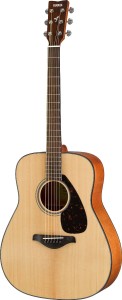
The Yamaha FG800 is remarkably affordable and surprisingly satisfying. A fantastic starter guitar or a welcome backup for professionals.
For the particularly budget-conscious studio owner, look no further than the Yamaha FG-800 Folk Guitar.
Maybe I’m biased because my own first acoustic guitar was the the Yamaha FG700, but “loud”, “bright”, and “punchy” are the first words that come to my mind when I still pick up that surprisingly incredible instrument.
The new 800 series is an upgraded version that now features scalloped bracing, making the guitar even louder and more punchy while still retaining warmth, thanks to the eastern mahogany back and sides.
The neck is pretty slim and it has a satin finish as opposed to an overly glossy one. This is always a great feature on an acoustic guitar, especially for electric players, because it makes the instrument feel faster and easier to move around on.
It is simply amazing to me that this guitar only costs $200. So, if you are looking to get your first acoustic guitar, or a great beater instrument to have around when inspiration strikes, or a solid backup for your studio, this is probably one of the best instruments you can buy for under $500.
5. Yamaha LL16-12 ARE 12-String Guitar (Street Price: $899)
Yamaha really does provide some of the best value for the money in the budget acoustic guitar world, and have duly earned their second slot on this list with the LL16-12 ARE 12-String.
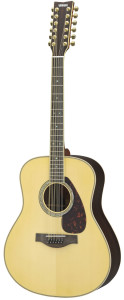
If your studio guit-arsenal is in need of a 12-string without breaking the bank, look no further than the Yamaha LL16-12.
Every studio should have a 12-string guitar around, and this is perhaps one of the best available—and not just at this price.
Yamaha treats this guitar with their “Acoustic Resonance Enhancement” technique (or “ARE”), which is a way of artificially aging the wood for a more vintage sound.
Don’t expect these guitars to sound like a broken-in 1960’s Gibson J-45, but do expect a cohesiveness between the sound of this guitar and the other guitars that have been aging in your studio for a couple of years.
This guitar also comes stock with an ebony fretboard and a hardshell case, two features you won’t typically find in a guitar under $1,000. This ebony fingerboard, combined with the Englemann spruce top, and rosewood back and work well together to create a rich, full and clear sound that’s ideal for a 12-string.
A lot of cheaper 12-string guitars tend to skimp on providing really decent tuner mechanisms, and so many of them can go out of tune much too easily. This can be especially annoying when you’re recording—and doubly so when you have double the number of strings to contend with!
Fortunately, the 12 gold-plated tuners on this guitar are remarkably stable, and will keep you in tune throughout your session. If you’re looking for the jangly chime of a 12-string for your next recording date, look no further than this phenomenal instrument.
6. Ibanez AELBT1 Baritone Guitar
For all your acoustic Djenting needs, who else can you turn to besides Ibanez?
Although I definitely would not recommend you buy this as your first studio acoustic, what I can recommend is considering adding the AELBT1 Baritone to your guitarsenal as a way of adding some low end and percussive body to your mixes.
When double tracking acoustic guitars, many players will use a capo and creative chord inversions to create the illusion of a shimmering 12 string guitar in their mix. Depending on your needs, you might want to take this idea a step further and add a Baritone guitar to your arsenal to create the sounds of a massive 18 string guitar.
Baritone guitars can also work especially well as a percussion instruments, as the body of a baritone is physically larger, allowing you to smack it with your palm and get some pretty interesting textures for your next recording. This is perhaps the most obscure guitar on the list, but this means that owning one can help separate your acoustic guitar recordings from the run of the mill.
Summing it Up
I hope this list helps you find your next great acoustic guitar for the recording studio. All of these options sound great unplugged, and should be among the easiest in their price range to mic and get great sounds from in the studio. A few of them ever offer added pickups for employing some of the more creative techniques in the producer’s’ toolbox.
If you wind up with one of these models, let us know how it treats you. And if you have a recommendation of your own, please let us know in the comments below!
Please note: When you buy products through links on this page, we may earn an affiliate commission.







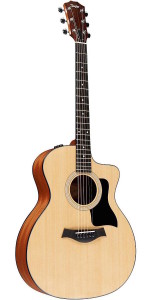
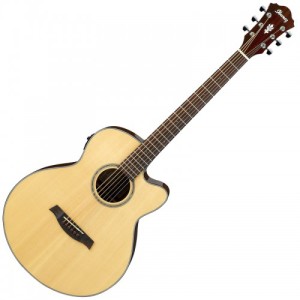
Joseph Worley
July 5, 2016 at 10:30 am (9 years ago)This article very useful. I hope have a chance to try above list. Thanks again. I also share a similar topic: http://www.musicinstrumentscenter.com/top-5-best-acoustic-guitar/